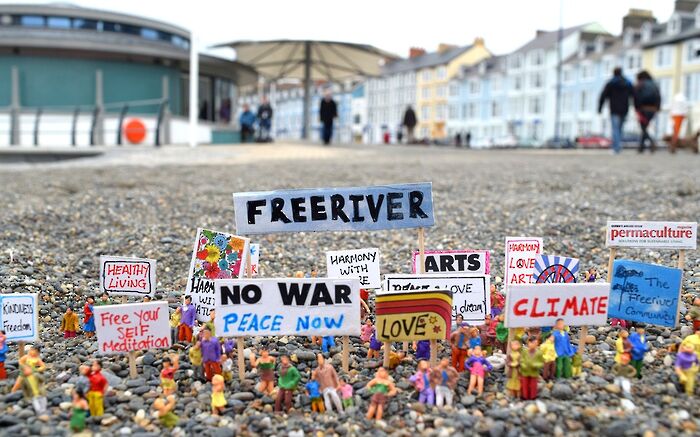Re-discovering nature through a camera lense
Since the beginnings of photography, images of nature have traced our relationship with our environments. Mathias Gjesdal-Hammer discusses the photographers which have shaped his perspective

To a degree, the history of photography can be described by examining how various schools of photographers have depicted nature. Early pioneers such as William Henry Jackson and Ansel Adams typically sought to capture natural scenes in all their glory, photographing American national parks and untamed wild landscapes. Later, the new topographic photographers (such as Robert Adams, Stephen Shore and Bernd and Hiller Becher) shifted their lenses toward the relationship between the natural landscape and industrial development. Drawing on this approach, many contemporary photographers have focused on the close relationships of dependence and interference between human and nature.
Human Nature, Lucas Foglia's latest photobook, traces our dysfunctional relationship with nature through images of urban landscapes, greenhouses and climate-change scientists. Underlying the work are unexpected ironic and wryly conceptual images such as a McDonald's with a green roof, a slaughterhouse with a mural of idyllic farm life and a taxidermy elk in the middle of an office landscape. While some of the photos draw on the National Geographic style of straight-forward documentation of natural wonders, this is subverted through Foglia’s eye for the absurd. Foglia also devotes a large part of the work to images of climate scientists and research programs.
One particularly arresting image shows a woman on the edge of a cliff wearing electrodes measuring cognitive responses in nature. Given the Trump administration’s enduring commitment to cutting climate research, the series has taken on an explicitly political slant. Even so, the photographs cannot be reduced simply to advocacy: Foglia’s photographs do not focus on the immediate consequences of climate change, but on our continuing desire to be immersed in nature. Summing his work up, Foglia states that “now there is no place on Earth unaltered by people, which has led many to argue that Nature no longer exists. At the same time, research has suggested that time in wild places is integral our health and happiness.”
By revealing the beauty of the ordinary and common-place, Epstein and Bosworth have opened my eyes to the pleasures of the quotidian
Mitch Epstein's New York Arbor turns trees into the central characters of his work, looking at the ways in which trees shape and transform the city. Using an 8x10 large format camera and black and white film, Epstein captures the shapes and textures of the myriad of trees in New York. The book follows the changes of the seasons, starting with bare winter trees, before moving into blooming spring trees and then back to more wintery trees.
Epstein also reveals the history closely tied to many of these trees. His photograph of an English Elm in Washington Square Park, for example, takes on new connotations when it is revealed that it is called the Hangman’s Elm because legend has it revolutionary war traitors were hung from it. Epstein’s careful eye for these trees is remarkable and is all the more refreshing amid the increasingly conceptual and idea-heavy landscape of contemporary photography.
Barbara Bosworth's The Meadow is the culmination of 10 years spent visiting a field in Carlisle, Massachusetts. The work explores this large patch of farmland reclaimed by nature, capturing vibrant woodlands and abandoned paths. The work is a collaboration with writer Margot Anne Kelley, whose writings trace the histories of the former owners of the land and documents the flora and fauna of the pasture. These texts include writings on how different species of fireflies co-exist and how the moss on the stones are in a symbiotic relationship with other fungus and algae. The combination of text and images, then, combines the rigour of a scientific study with a creative exploration of the meadow. The work is also a powerful meditation on the act of revisiting and reflecting on a singular place. In her artist statement, Bosworth suggests that the work is “a meditation on the shifting perspective that occurs when one repeatedly sees the same place through new eyes.”
While Foglia's work may be more impressive in its ambitious scale and global outlook, Epstein and Bosworth's local perspectives have stayed with me for longer. The simplicity of their approach allows for the beauty of the natural world to shine through and illuminates the subtle relationships between humans and nature.
Indeed, their careful attention to the modest joys of New York trees and American pastures has led me to appreciate the charms of the Grantchester Meadows and Cambridge scenery in a new light. It has also made me stop and admire the massive horse chestnut and London plane trees that are scattered around Cambridge. This, it seems to me, is one of the greatest strengths of photography. By revealing the beauty of the ordinary and common-place, Epstein and Bosworth have opened my eyes to the pleasures of the quotidian and made me look more closely at my surroundings.
 News / Eight Cambridge researchers awarded €17m in ERC research grants27 December 2025
News / Eight Cambridge researchers awarded €17m in ERC research grants27 December 2025 News / Clare Hall spent over £500k opposing busway 24 December 2025
News / Clare Hall spent over £500k opposing busway 24 December 2025 Comment / League tables do more harm than good26 December 2025
Comment / League tables do more harm than good26 December 2025 Comment / The ‘class’ of Cambridge24 December 2025
Comment / The ‘class’ of Cambridge24 December 2025 News / Caius mourns its tree-mendous loss23 December 2025
News / Caius mourns its tree-mendous loss23 December 2025










